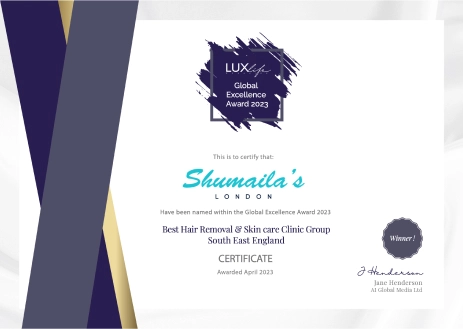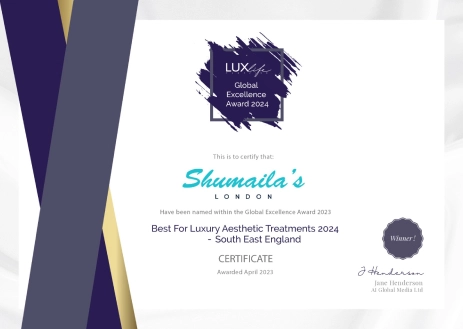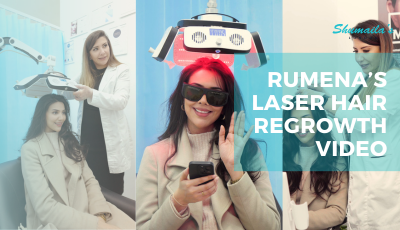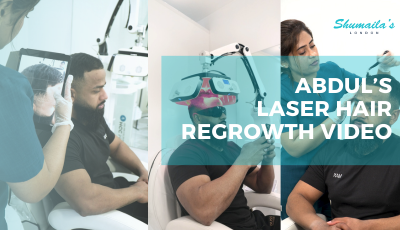Our staff undergo rigorous training, ensuring they deliver the highest standard of care in every session. At our clinic, we prioritize treatments backed by clinically proven studies, guaranteeing effective and safe solutions for your hair restoration journey. Trust us to provide honest and realistic assessments of your hair growth expectations, guiding you towards achievable results. Experience the confidence of fuller, healthier hair with Shumaila’s London – where excellence and transparency converge.





Hair Restoration and Regrowth
Non-surgical
Safe and Effective
For all genders
Support and Guidance
Types of Conditions
Genetic Hair Loss
Androgenetic Alopecia:: This is the most common type of hair loss. Also known as male or female pattern baldness, this is the most common form of hair loss. It is influenced by genetic and hormonal factors and often presents as a receding hairline in men and thinning hair in women.
Patchy Hair Loss
Alopecia Areata: An autoimmune condition where the immune system attacks hair follicles, leading to patchy hair loss.
Stress-Related Hair Loss
Telogen Effluvium: A temporary hair loss that occurs after a physical or emotional shock, like illness or stress.
Hair Pulling Hair Loss
Traction Alopecia: Hair loss caused by continuous pulling or tension on the hair from tight hairstyles.
Treatment-Related Hair Loss
Anagen Effluvium: Rapid hair loss resulting from medical treatments like chemotherapy.
Infection-Related Hair Loss
Scalp Infections: Hair loss due to infections such as ringworm affecting the scalp and hair follicles.
Diet-Related Hair Loss
Nutritional Deficiencies: Hair thinning and loss caused by lack of essential nutrients like iron and vitamins.
Hormone-Related Hair Loss
Hormonal Imbalances: Hair loss resulting from conditions like PCOS, thyroid disorders, and menopause.
Scar-Related Hair Loss
Cicatricial (Scarring) Alopecia: Permanent hair loss due to the destruction of hair follicles and their replacement with scar tissue.
Hair Pulling Disorder
Trichotillomania: A psychological condition where individuals have an urge to pull out their own hair, causing hair loss.
Medicine-Related Hair Loss
Medications and Medical Treatments: Hair loss as a side effect of medications used for various health conditions.
Disease-Related Hair Loss
Chronic Illnesses: Hair loss associated with diseases like lupus, diabetes, and syphilis.
Treatments for Hair Loss
Topical Solution
Minoxidil (Rogaine): A topical solution applied directly to the scalp to stimulate hair growth and slow hair loss. It's available over-the-counter and can be used by both men and women, typically showing results within a few months of consistent use.
Low-Level Laser Therapy
Low-Level Laser Therapy (LLLT): Uses red light to stimulate hair follicles and promote hair growth. This non-invasive treatment can be done at home with special laser caps or combs, or in a clinical setting, and is suitable for both men and women.
Platelet-Rich Plasma (PRP) Therapy
Platelet-Rich Plasma (PRP) Therapy: A treatment where a patient's blood is processed to concentrate platelets, which are then injected into the scalp to promote hair growth. PRP leverages the body's natural healing processes and is often used in conjunction with other treatments for enhanced results.
Scalp Micropigmentation
Scalp Micropigmentation: A cosmetic procedure where tiny pigment deposits are placed in the scalp to create the appearance of fuller hair. It’s a non-surgical solution that can effectively camouflage thinning areas and create the illusion of density.
Dietary Changes
Dietary Changes: Ensuring adequate intake of vitamins and minerals such as biotin, zinc, and iron can support hair health and growth. A balanced diet rich in these nutrients can help reduce hair thinning and promote stronger hair.
Microneedling
Microneedling: A procedure that uses tiny needles to create micro-injuries in the scalp, potentially stimulating hair growth through the body's wound-healing response. Often combined with topical treatments to enhance absorption and efficacy.
Exosome Therapy
Exosome Therapy: An innovative treatment involving the injection of exosomes, which are tiny vesicles derived from stem cells, into the scalp. These exosomes promote regeneration and repair of hair follicles, encouraging natural hair growth and reducing inflammation. Exosome therapy is a promising, non-invasive option with minimal downtime.
Hair Transplant Surgery
Hair Transplant Surgery: Involves transplanting hair follicles from a donor area (usually the back of the scalp) to the thinning or balding areas. There are two main techniques: Follicular Unit Transplantation (FUT) and Follicular Unit Extraction (FUE), both of which offer permanent and natural-looking results.


Why Experience Laser Hair Regrowth at Shumaila’s London?
When will you start seeing results?
Laser treatment for hair loss has proven to deliver exceptional results for many people. Most clients start to see results in the first month of treatment. However, the efficacy of the results depends on individual patients’ hair condition, medical condition, age and scalp.
By the third month of treatment, there should be visible signs of hair growth.
LLLT has been clinically proven to repair damaged hair follicles and help hair to grow back thicker, stronger and healthier.
Watch our video
Laser hair regrowth therapy, otherwise known as low-level laser therapy (LLLT), is a highly effective non-surgical treatment for hair loss in men and women. It is an FDA (Food and Drug Administration) approved technology that helps stimulate your hair follicles by removing blockages from vessels.
LLLT therapy uses medical-grade lasers to administer low-level laser light to the scalp. The light is delivered on a wavelength easily absorbed by the molecules of the hair follicles. Once the light has penetrated the scalp, it stimulates stem cells that repair damaged follicles and promote new hair growth.
Laser hair regrowth therapy is one of the best hair loss treatments for a wide range of people, regardless of their sex, age or the cause of their condition. LLLT is widely regarded as a safe, non-invasive treatment that delivers results with minimum downtime and side effects.
To find out more about how LLLT works, check out the frequently asked questions below or request a callback and one of our experienced therapists will be in touch to discuss the options available to you.
What are the benefits of Laser Hair Regrowth?
- Visible results within one month
- FDA-approved and completely safe
- Stimulates new hair growth
- Reduces hair fall
- Removes blockages from hair follicles
- Normalises blood flow to the scalp
- Removes hair fungus
- Boosts self-confidence
- Helps alopecia
- Helps with post-pregnancy hair loss
Our Offers
Frequent Asked Questions
On average, we naturally shed about 100 strands of hair daily. Maintaining a normal hair thickness entails replacing these lost strands at a similar rate. Should you observe a surge in hairs lingering on your brush post-brushing or in the sink after shampooing, it might signal the onset of hair thinning. Similarly, a broader part or a thinning crown could serve as early indicators of hair loss.
We understand the myriad causes behind male baldness, whether it’s male pattern baldness, receding hairlines, or conditions like alopecia. We also recognize the profound effect hair loss can have on self-esteem and confidence. That’s why we provide discreet and comfortable solutions tailored specifically for men experiencing hair loss. Rest assured, our confidential environment ensures your journey to reclaiming your hair is both seamless and supportive.
Various factors, including age, pregnancy, genetics, and medications, may lead to female pattern baldness, along with conditions like alopecia, traction alopecia, cancer, and trichotillomania. Shumaila’s London specializes in personalized solutions designed specifically for addressing female hair loss concerns. Recognizing the delicate nature of hair loss treatment, we prioritize privacy with discreet consultations and treatment areas.
Laser hair regrowth is designed to stimulate hair follicles that are weak or lack sufficient circulation. As a standalone treatment it may be fine, or we may suggest combining this with other treatments. Either way, we do see a good success rate. If you are unsuitable for treatment, or suited to something else, we would be transparent and honest about that.
One of our friendly consultants will contact you to answer your questions, and to book a consultation for your chosen treatment.











